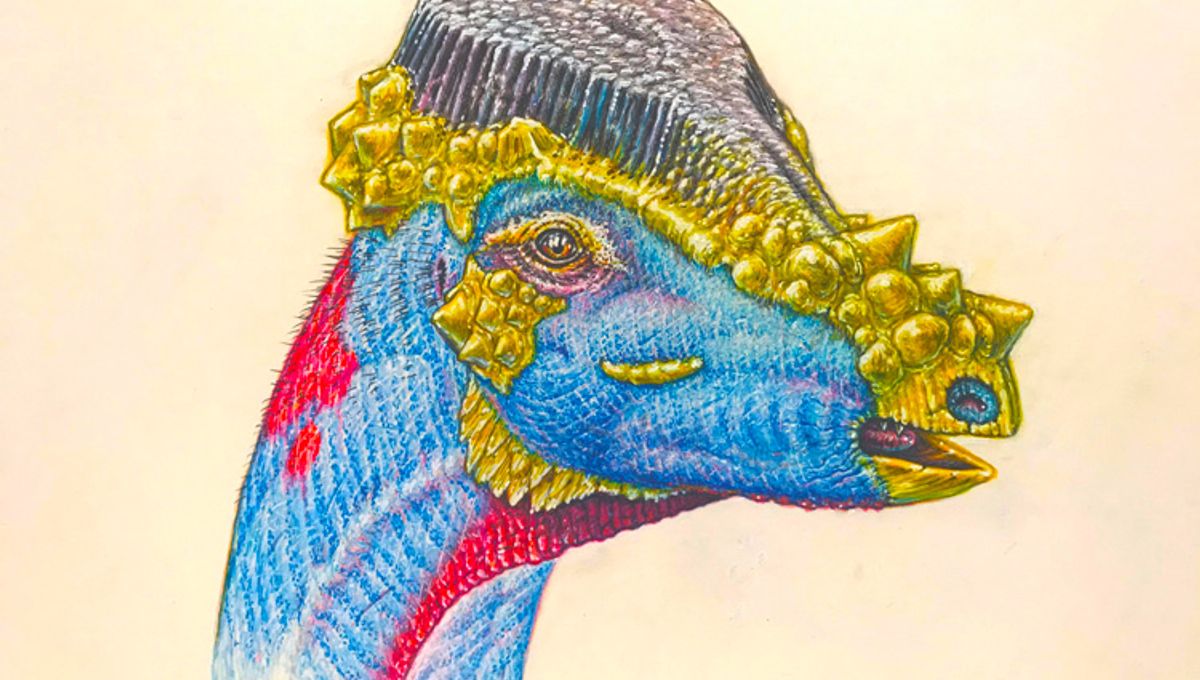
A newly-described species of pachycephalosaurid called Platytholus clemensi that lived around 68 million years ago during the Late Cretaceous may have rocked some fabulous keratin headgear, a recent paper detailing the analysis of a partial skull has revealed.
Named MOR 2915, the skull was found in 2011 by study author John R. “Jack” Horner, of Chapman University in Orange, California, in a “locally slumped siltstone lens in the lower third of the Hell Creek Formation […] on the Charles M. Russell National Wildlife Refuge in Garfield County, northeastern Montana,” the study authors write.
Pachycephalosaur skulls are like “a bowling ball in the fossil record,” study author Mark Goodwin, of the University of California, Berkeley, explained in a statement. “Their skulls roll around, get buried, and when exposed on the surface, they’re very robust, so they can withstand a lot of weathering and erosion sitting out there. More than once, people have walked over an area all summer and discovered that what they thought was just a rock, because it looks like a glacial cobble, turned out to be a really nice dome.”
The arrangement of blood vessels in the ancient noggin hints at how this dino accessorized. “What we see are these vertical canals coming to the surface, which suggests that there might be keratin on top, but it’s oriented vertically,” Horner said. “I think these pachycephalosaurs had something on top of their head that we don’t know about. I don’t think they were just domes. I think there was some elaborate display on top of their head.”
“We don’t know the exact shape of what was covering the dome, but it had this vertical component that we interpret as covered with keratin,” explained Goodwin. Keratin is a protein that also makes up your hair and fingernails.
“The combination of cranial histology after thin-sectioning the skull and CT scanning gave us a much richer body of data and forms a basis for our hypothesis that there was a keratinous covering over the dome,” Goodwin continued. “We know the dome was covered with something, and we make a hypothesis, at least in this taxon, that it had a vertical structural component, unlike Triceratops, T. rex and other dinosaurs, which had hard skin or keratin closely covering the bone.”
The new species was named Platytholus clemensi after palaeontologist William Clemens, who died aged 88 in 2020.
Compared to other pachycephalosaurids from around the same time period found in Hell Creek, the authors note that Platytholus clemensi was “intermediate in size between the small-bodied Sphaerotholus species and the largest pachycephalosaurid, Pachycephalosaurus wyomingensis that are well represented by numerous specimens from the Hell Creek Formation.”
MOR 2915 had an injury to its skull, which is “probably the first unequivocal evidence of trauma in the head of any pachycephalosaur, where the bone was actually ejected from the dome somehow and healed partially in life,” Goodwin explained. “Something hit the top of this guy’s head and damaged it, and it was something that was severe,” Horner added.
However, the two are skeptical that it could have been the result of the dinosaurs headbutting each other. “That’s the first place everybody wants to go – let’s crash them together. And, you know, we just don’t see any evidence of it, histologically,” Horner said. “I don’t see any reason to turn dinosaurs into mammals, rather than just trying to figure out what they might be doing as bird-like reptiles.”
This discovery shows that pachycephalosaurs were more diverse before the Chicxulub impact than we thought, the researchers write in the paper, and “that they may have had tiered niches in part by size, both of which have implications on the ecological dynamics of these dinosaur communities in a key period of their history.”
The study is published in the Journal of Vertebrate Paleontology.
Source Link: Newly Discovered Pachycephalosaurid May Have Had A Fancy Headpiece